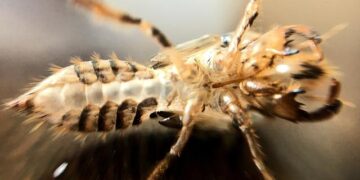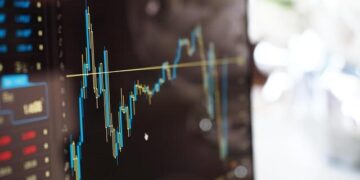By treating molecules as geometric tessellations, scientists devised a new way to forecast how 2D materials might self-assemble.

Samuel Velasco/Quanta Magazine
Introduction
On a Saturday afternoon in the fall of 2021, Silvio Decurtins was leafing through a paper with a title that could have been pulled from a comic book for mathematically inclined teens: “Plato’s Cube and the Natural Geometry of Fragmentation.”
It wasn’t the unusual title that caught his eye, but the pictures on the third page — geological patterns at every scale from cracked permafrost to Earth’s tectonic plates. Decurtins, a chemist at the University of Bern, was reminded of the materials he had been studying. “Ah! I also have patterns!” he thought. “It’s just a matter of scale.”
Decurtins’ patterns weren’t formed by cracks in the earth, but by molecules: they were mosaic-like tilings of molecules in sheets just one molecule thick. These 2D materials can have peculiar and practical properties that depend on how their molecular building blocks are arranged.
For example, it’s possible to arrange molecules into 2D patterns that use electrons as computational bits or to store data. Patterns with gaps can act as membranes. And patterns that contain metal ions can be powerful catalysts.
It’s possible to build these 2D materials atom by atom, but doing so is expensive, difficult and time-consuming. So many scientists, including Decurtins and his colleagues, want to design materials that assemble themselves. Predicting how molecules self-assemble into 2D sheets is one of the grand challenges of materials science, said Johannes Barth, a physicist at the Technical University of Munich.
That’s because nature has not been especially forthcoming with her molecular design philosophy. Forecasting self-assembly is a job for supercomputers, and the heavyweight programs required can take days or weeks to run.
So Decurtins got in touch with Gábor Domokos, the study’s first author, a mathematician at the Budapest University of Technology and Economics. Decurtins wondered if the same geometry that describes how planets fracture could explain how molecules assemble.

Gábor Domokos, a mathematician at the Budapest University of Technology and Economics, used geometry to describe geological patterns at every scale.
Courtesy of Gábor Domokos
Introduction
Over the next year, Domokos and his colleagues used geometric thinking to unpack the rules of molecular self-assembly — devising a new way to constrain the mosaics that molecules can form, using only the simple geometry of tessellation.
“At first, they did not believe that you can do it,” Domokos said. “They were doing artificial intelligence, supercomputing and all this kind of jazz. And now they are just looking at formulas. And this is very relaxing.”
From Planets to Atoms
After Decurtins got in touch, Domokos tried to sell the idea to Krisztina Regős, his graduate student. Decurtins had sent a handful of images depicting patterns at an atomic scale — tilings of a molecule that had been designed and synthesized by his colleague Shi-Xia Liu — viewed through the eye of a powerful microscope. Domokos wanted to see if Regős could use the geometry that he had originally developed to describe geological fractures to characterize the patterns in Decurtins’ images.
To get started, Regős treated the 2D materials as simple polygonal tessellations — patterns that fit together with no gaps and infinitely repeat. Then, following Domokos’ approach, she calculated two numbers for each pattern. The first was the average number of vertices, or corners, per polygon. The second was the average number of polygons surrounding each vertex.
Together, those two average values are like a pattern’s GPS coordinates. They give its location within a landscape of all possible tessellations.
This landscape is called the symbolic plane. It is a simple 2D grid with the average number of shapes per vertex on the x-axis and the average number of vertices per shape on the y-axis. Each tessellation should plot to exactly one point within the plane. A perfect honeycomb pattern, for instance, is a tessellation of six-pointed hexagons that meet in trios at each vertex — a point at (3, 6) in the symbolic plane.
But most natural mosaics, from rock cracks to molecular monolayers, are not perfectly periodic tessellations.
For example, the cells of a real wax honeycomb are not all perfect hexagons. Bees make mistakes. But messy as it may be, a honeycomb is still, on average, a honeycomb. And on average, it still plots to a point at (3, 6) in the symbolic plane. Rather than being an oversimplification, Domokos’ method of calculating averages is insightful, said the mathematician Marjorie Senechal of Smith College, who reviewed the new study. By throwing out the mistakes and treating patterns as averages, it reveals a sort of ideal reality that’s normally buried beneath heaps of happenstance.
But when Regős tried to apply this method to Decurtins’ molecular pictures, she quickly ran into trouble. “I started to put them on the symbolic plane,” she said, “and then I realized that I can’t.”
The problem was scale. Unlike the geological patterns Domokos had worked with before, the molecular mosaics are really patterns within patterns. Viewed at different magnifications, they have different geometries. Regős couldn’t describe the molecular mosaics with a single pair of values because the patterns plotted different points on the symbolic plane, depending on an image’s magnification. It was a bit like zooming in on a hexagonal tiling and finding that its basic building blocks are really triangles.

A nanometer-scale image of two intricate patterns formed by the same molecule.
Remy Pawlak and Ernst Meyer
Introduction
“So Kriszti said: OK, this is a mess,” Domokos said.
Then she figured out how to tidy up the mosaics. Instead of forcing the materials’ nested patterns into a single pair of averages, she broke them into three levels of organization, each represented by its own point on the symbolic plane.
At the lowest level, the atoms in each molecule combine to form a polygon. Those molecules then connect to each other via hydrogen bonds, creating a tessellation of polygons. Finally, at the most zoomed-out level, individual molecules shrink into points, and those points connect to form a mosaic.
In Regős’ new framework, each level is represented as a simple mesh of points and lines — a graph.
Using graph theory to describe molecular patterns “is very powerful,” said Carlos-Andres Palma, a chemical physicist at the Chinese Academy of Sciences and Humboldt University of Berlin. Traditionally, scientists classify patterns based on their symmetries. But that doesn’t reflect the messiness of reality — real nanomaterials are rarely perfectly periodic or symmetric, Palma said. So reducing molecular patterns to simple, flexible graphs “allows us to communicate with the natural world, in my opinion, much better,” he said.
Predicting Patterns
Regős and Domokos now had a way to describe Decurtins’ molecular mosaics, a key step toward predicting how molecules might self-assemble.
“We’re really quite bad at predicting,” said Ulrich Aschauer, a computational physicist at the University of Salzburg who works on self-assembly.
Traditionally, scientists use a variety of methods to predict how molecules will self-assemble. Aschauer simulates how molecules interact on a surface. Then he identifies the patterns that require the least energy to form, which should be the most likely to appear. Other scientists screen huge numbers of randomly generated patterns, or they train machine learning algorithms to forecast self-assembly. All of these methods are computationally costly — Palma recalled how a colleague once simulated water molecules for years, just to make a single prediction about how water self-assembles. Machine learning algorithms also have blind spots; they only learn what you feed them, Aschauer said. And it’s impossible to check every possible pattern, so scientists often have to guess which ones are worth considering in the first place.
“Our starting guess determines the final thing that we find,” Aschauer explained. “And it’s a huge problem because if I don’t have the right intuition to start with, I end up in the wrong.”

When Krisztina Regős was a graduate student at the Budapest University of Technology and Economics, she devised a way to describe molecular patterns as simple tessellations.
Gabriel P. Smith
Introduction
But Regős and Domokos’ geometry was agnostic. It simply treated molecules as points and bonds as lines. It didn’t require a starting guess.
After meeting Aschauer and Decurtins in person in Switzerland, the mathematicians finally turned to the messy business of trying to predict patterns rather than simply describe them.
Gömböcs and Bridges
As it stood, Regős’ system could constrain a pattern’s middle level of organization, in which molecules are polygons and hydrogen bonds are lines. But she couldn’t work upward from the molecular tile to predict the large-scale mosaic. Without something to mathematically link all three levels, her model was like a ladder with a missing rung.
Domokos decided it was worth checking in with Kostya Novoselov — a physicist at the National University of Singapore who shared a Nobel prize for synthesizing graphene, perhaps the most famous 2D material of all. The two had met accidentally earlier that year, after Novoselov ordered a conspicuous number of Gömböcs, new geometric forms that Domokos had discovered, from a store in Budapest.
With Novoselov’s input, Domokos and Regős refined their geometric model. Until then, they’d used just three levels of organization: the molecule, the medium-scale pattern, and the large-scale pattern. Novoselov suggested adding a fourth level — a bridge between the medium and large levels. The equation describing this bridge linked the geometry of the smallest and middle levels with the largest level, the molecular mosaic.
With the bridge in place, the team could now take the molecular tile and work upward to constrain its potential large-scale patterns using a simple system of five algebraic equations and inequalities that could fit on the back of an envelope. In these mathematical statements, the variables are a pattern’s coordinates on the symbolic plane, plus some terms describing a molecule’s structure. Taken as a whole, the system relates each level of organization to the others, and to a pattern’s coordinates on the symbolic plane.
Plotted on the symbolic plane, a molecule’s possible large-scale arrangements fall on a small slice of the curve defining all possible space-filling 2D molecular patterns. The researchers could now use the starting molecule to constrain that slice.
But they weren’t yet convinced that their “slice” of possible patterns was small enough. If it was too wide, it wouldn’t be a very useful constraint. When Liu plotted the structures of 2D water ice on the symbolic plane, she found that they fell perfectly on the extreme ends of the method’s predicted range. The bounds couldn’t be improved.
“This is nature’s language here,” Domokos said. “That was a big surprise for me.”
Growth and Form
Near the end of the project, in May 2022, the Hungarians again traveled to Switzerland. This time, their colleagues surprised them with a visit to the microscope that had produced the images they’d been working with — and that was when Regős and Domokos finally realized what they’d done: By mathematically linking large-scale mosaics with molecular bonds on a much smaller scale, they had captured something of the invisible tangle of interactions that ultimately dictate how molecular patterns form. Their geometry could “see” things the machine could not.

Gábor Domokos with a scanning tunneling microscope in Basel, Switzerland — the instrument that made the images he and Krisztina Regős used to develop their geometric framework for predicting molecular mosaics.
Courtesy of Krisztina Regős
Introduction
“It was unbelievable,” Regős said. “We went down to the basement and saw that they’re at the limit of our science.”
Using a microscope to understand self-assembled patterns, Novoselov said, is like trying to understand grass by taking pictures of it from above. Those pictures tell you a lot about grass, “but definitely not everything,” he said. They reveal little about the grass’s roots or how it grows. Domokos and Regős’ framework cannot see the roots perfectly, but it offers an entirely new way to sketch them, by linking a pattern’s molecular building blocks to the eventual mosaic.
“They are continuing a wonderful old tradition of studying the relationship between growth and form,” Senechal said, “which is really central to understanding anything in the world around us.”
Molecular self-assembly often begins with a small patch of material that grows into a larger pattern. However, the new mathematical framework assumes an infinite pattern, not a finite patch. Adapting the work to describe how finite patches grow into larger patterns could be a step toward genuine prediction, Palma said. Aschauer said he plans to use the geometry as a guide to dead ends and promising but unexplored corners in the landscape of possible patterns. And using the mathematical language of the symbolic plane to train machine learning models could be exciting, he added.
“I’m really intrigued about the beauty of it,” Novoselov said. “With very little — just a fundamental mathematical approach, which is really pure geometry, just graphs in 2D — you’re able to predict so many things.”
The math is simple, Senechal said. But “to see simplicity,” she added, “takes a lot of sophistication.”
Next article
How the Brain Protects Itself From Blood-Borne Threats
>>> Read full article>>>
Copyright for syndicated content belongs to the linked Source : Quanta Magazine – https://www.quantamagazine.org/the-simple-geometry-that-predicts-molecular-mosaics-20230621/































